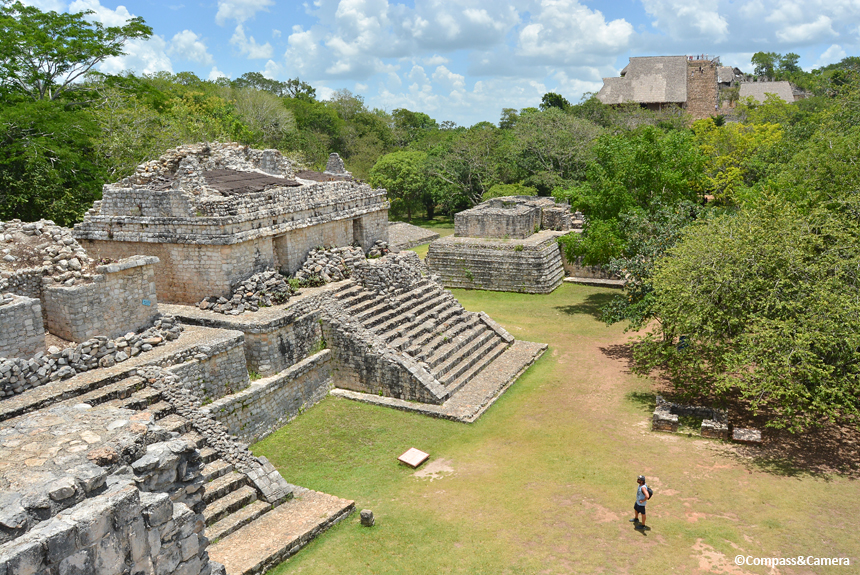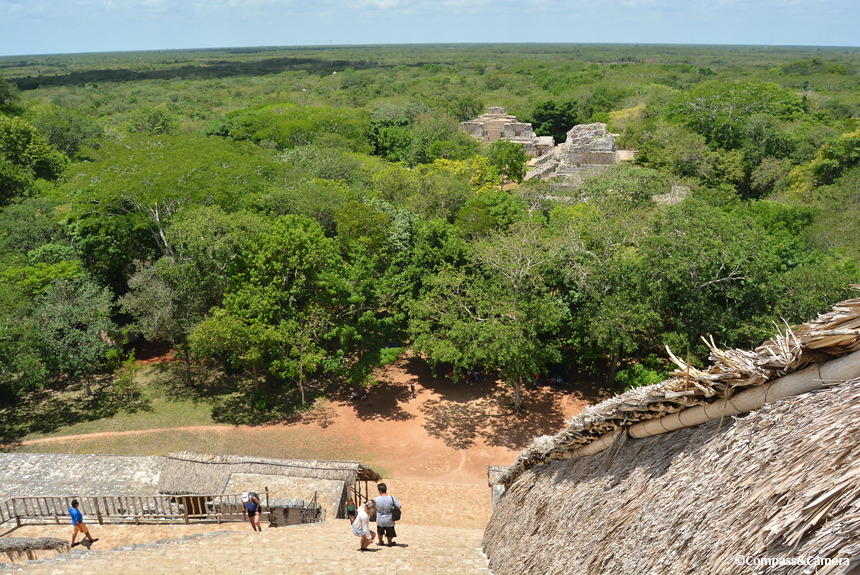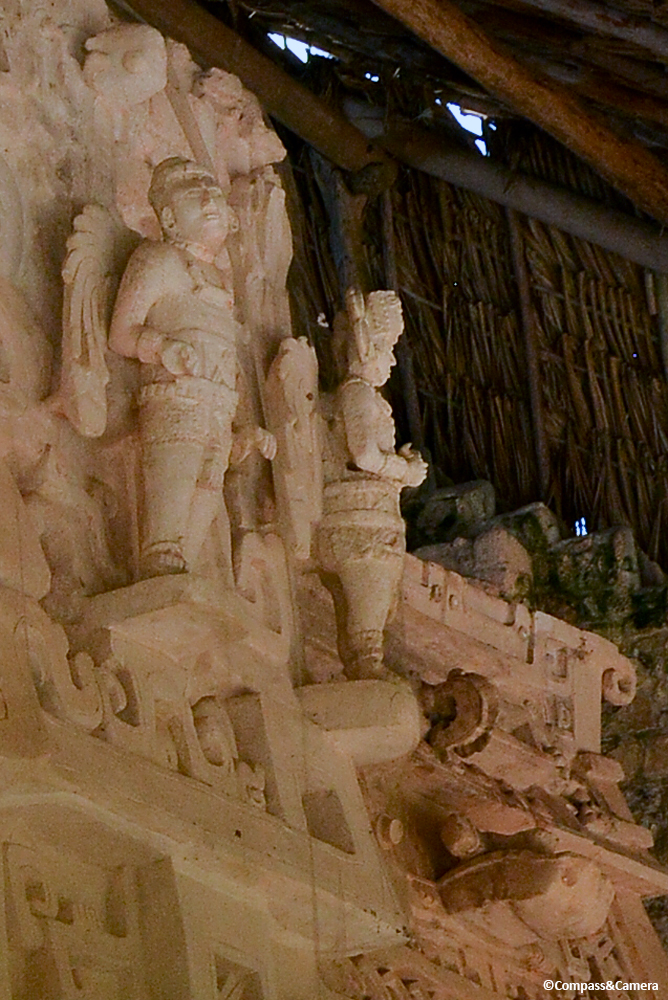Angelic Ek Balam
September 15th, 2020
A hand-carved sign welcomes us to Ek Balam, above an open gate to a wide dirt path leading into this Mayan site from the Pre-Classic and Classic periods (700-1100 AD). Mayan sites were often developed over centuries, with one structure built on top of another, extending their timeline beyond one period.
The path we’re on seems simple enough; wide and worn from countless footsteps. But this is a sacbe — the remnant of what was once a Mayan road, cleared of vegetation and built about 18 inches/45 cm above ground level, presumably to even out the irregularity of the jungle terrain.
Sacbeob (the plural form of the word) lead to all of the larger Mayan sites, Ek Balam included. There are two of them here which terminate at the crumbling stone walls surrounding the site. Sacbeob were a feat of engineering, not only because they were built through dense jungle but the stone used to build up and elevate them would have required a huge workforce and a lot of hours. There is also evidence that sacbeob may have been covered in stucco, rendering a smoother surface for whatever or whoever was traveling upon them.
Ek Balam’s entry arch is interesting for its angularity — not nearly as elegant as Roman versions that appeared centuries earlier, but still a striking shape in negative space at the entrance to the site. Perhaps there were torches and guardians at this outpost of Ek Balam.
An elevated stone path leads to the Oval Palace, built like a tiered wedding cake with graduated round forms leading to the temple at the top. At ground level, a series of doorways leading to rooms in the palace have perfectly cut heavy timber lintels supporting the stone above them. The tools and methods of construction used throughout the site are impossible to know completely, but craftsmanship is evident everywhere.
From the top of the Oval Palace, we see “the Twins” to the left in repeated forms with separate staircases leading up to elevated interiors under decaying roofs. King and queen? Brother and sister? No one knows for sure who used these duplicate structures but there are several rulers named in the carved stelae across the lawn from the Twins.
North of the Twins, Ek Balam’s acropolis towers over the site in a six-story form around an ominous staircase of 106 steps. Mayan staircases run at a 45-degree angle — a bit steeper than the 37-degrees we’re used to. The steps are shallow as well, indicating that people living in the region were likely of smaller stature than today.
Standing at the base of a Mayan staircase is intimidating — muster your endurance, focus your attention and know that any misstep can result in an express route to the bottom.
From the top, the smaller structures of Ek Balam peek out from the landscape of endless jungle canopy extending to the horizon. It would be impossible to know if an enemy were approaching under the beautiful green blanket of foliage. Maybe then this acropolis was less about what was below and more about what was above — sky, stars, sun and moon, and the Mayan deities that influenced everyday life.
Ek Balam’s most notable feature sits under a thatched roof about halfway up the staircase. An elaborately carved stucco frieze adorns the wall of an interior chamber that was the tomb of Mayan ruler Ukit Kan Le’k Tok. The frieze is designed as the mouth of a deity with fangs jutting out from the lower platform. This is the only stucco frieze found in Mayan civilization so far.
Upon seeing the frieze I thought it was a recent work of art but its near perfect condition is due to it being behind stone walls until they were recently removed. I have to say, with climate change affecting the region more and more, I fear for the frieze being only somewhat protected at a high elevation. Hurricane-force winds could take the roof right off, leaving the frieze entirely exposed.
The finishing touch of this unique stucco frieze is the winged “angels” standing at the top — the only angels of known Mayan history. I would speculate … maybe these are The Twins? The reason for the duplicate structures? Maybe twins were an auspicious sign in Mayan culture; a rare gift from the gods; winged like sacred quetzals. We may never know for sure and that’s what’s so intriguing about Ek Balam and its cultural artifacts of Mayan history.
One thing we do know for sure is that the Mayans loved their ball game. Ek Balam has a nicely scaled court with angled side walls. The stone hoops have been lost to time but surely there were some spirited games here centuries ago in the land of the Black Jaguar, Ek Balam.
Tomorrow we meet Cobá.
Kelly
Post of the Day: Adding a bit of light to the darkness as we get through the pandemic together. This series features travel photos from my archives, shared with you while staying close to home.



















Great photos 😊
LikeLiked by 1 person
Thanks, Emily!
LikeLiked by 1 person
Cantik Alami Deeehhhhhh
LikeLike
Thanks!
LikeLike
Great series on the Mayan civilisation Kelly, just loving the flights on the magic carpet 🙂
Those stairs look quite challenging, not good to be climbing down on a rainy day!
LikeLiked by 1 person
Thank you! 🙂 So true. And going down is much more precarious than going up!
LikeLiked by 1 person
Wonderful post and stellar photography!
LikeLiked by 1 person
Thanks so much for stopping by! 🙂
LikeLike
They did like their steps, these people! Definitely intimidating 🙂 🙂 But the frieze is wonderful. Great photos, Kelly!
LikeLiked by 1 person
Yes, steps everywhere!! Thanks so much, Jo!
LikeLiked by 1 person
I have never heard of sacbeob – very cool! As for those super steep stone staircases: I scrambled up the huge one at Chichén Itzá when I was 5 months pregnant with my first child. At the top, I realized I was an idiot and proceeded to come the whole way down bumpity-bump on my bottom!
LikeLike
Whoa, five months pregnant?! That’s a lot of load to carry up those stairs. No shame in bumping on down. They’re difficult! Happy weekend!
LikeLiked by 1 person
Pingback: Rocky Cobá |
This took me right back, and also gave more info. And those stairs – I was determined to climb them (stupid I know) and basically hauled myself up on my left leg and came down on my butt lol. But nevertheless survived 🙂
Alison
LikeLiked by 1 person
Good for you getting up to the top! Funny, Lex commented that she went up the stairs five months pregnant and then came down on her butt. Definitely the safest way!
LikeLiked by 2 people
Pingback: Captivating Cobá |
Amazing how those stairs look no big deal looking up, but look OMG going down. Perspective changes reality.
LikeLike
So true! And on the way up you can lean into the incline a little bit, facing forward. But going down is very precarious, especially if you attempt to do so like it’s a “normal” staircase (facing away from the incline). Balance gets very tricky and top heavy. Best to crouch, squat or sit and bottom on down to be safe!
LikeLiked by 1 person
Pingback: Vamos a Valladolid |
Your photos from the top of the Acropolis make me dizzy just thinking about how I would get down and wondering if I could! Excellent shots. And the ones of the statues make me believe that climbing and viewing are all worth it when you get to see structures and art such as these. How truly fascinating!
LikeLike
Ek Balam is a powerful site. Small and easy to see, and in such great condition. Down is easy when you sit and go on your bum! 🙂 No shame in being safe!
LikeLiked by 1 person
A great tip you’ve given me!!! It would help me if I’m dizzy too!
LikeLiked by 1 person
Pingback: Sport & Skullduggery at Chichén Itzá |